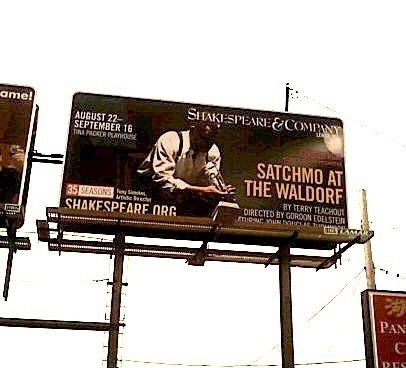Terry Teachout's Blog, page 140
August 21, 2012
TT: This is it
In honor of the first public performance of Shakespeare & Company's production of
Satchmo at the Waldorf
, I'd like to share with you a little tune from my childhood that I always post on my opening nights:
See you tonight!
See you tonight!
Published on August 21, 2012 17:57
August 20, 2012
TT: Almanac
"I steer my bark with Hope in the head, leaving Fear astern."
Thomas Jefferson, letter to John Adams (Apr. 8, 1816)
Thomas Jefferson, letter to John Adams (Apr. 8, 1816)
Published on August 20, 2012 18:03
TT: A week of Satchmo (II)
Louis Armstrong and the All Stars perform "Lazy River" at the Newport Jazz Festival in 1958:
Published on August 20, 2012 18:03
TT: Lookback
 From 2009:
From 2009:A minute or two before the house lights went down and the world premiere of The Letter got underway, Paul Moravec tapped me on the shoulder. "Turn around and look," he said. I was sitting in an aisle seat toward the front of the left side of the theater. I turned around and saw that all two thousand of the seats in the Santa Fe Opera's Crosby Theatre were full. Paul grinned. "Did you ever think you'd see anything like that?" he said. Mrs. T snapped a picture of the two uf us. Then we sat back down to watch the show.
Read the whole thing here .
Published on August 20, 2012 18:03
August 19, 2012
TT: T minus 2
 The first public performance of
Satchmo at the Waldorf
takes place on Wednesday night at Shakespeare & Company's Packer Playhouse in Lenox, Massachusetts. Needless to say, John Douglas Thompson, Gordon Edelstein, and I will be spending all day tomorrow rehearsing. Even so, I already feel good about the show, not because I'm feeling especially cocky about the play--it is what it is--but because of the phenomenal work that John, Gordon, and my other colleagues have done and are continuing to do. They are artists of the first rank, and I am privileged beyond measure to be working with them.
The first public performance of
Satchmo at the Waldorf
takes place on Wednesday night at Shakespeare & Company's Packer Playhouse in Lenox, Massachusetts. Needless to say, John Douglas Thompson, Gordon Edelstein, and I will be spending all day tomorrow rehearsing. Even so, I already feel good about the show, not because I'm feeling especially cocky about the play--it is what it is--but because of the phenomenal work that John, Gordon, and my other colleagues have done and are continuing to do. They are artists of the first rank, and I am privileged beyond measure to be working with them.The Boston Globe ran a feature on Sunday that conveys something of our collective excitement. This quote sums up my share of it: "'I'd call it a dream come true, except I never would have had the nerve to dream any of this,' Teachout said, shaking his head."
 To celebrate the occasion, I'll be posting daily videos drawn from TV broadcasts that Armstrong made during the last decade of his life, the period portrayed in Satchmo at the Waldorf. Just as my play shows what he was like off stage, so do these videos show what he was like on stage, giving everything he had and then some. "The people expect all that from me--coming out all chesty, making faces," he said in a 1965 interview. "That's me and I don't want to be nobody else. They know I'm there in the cause of happiness."
To celebrate the occasion, I'll be posting daily videos drawn from TV broadcasts that Armstrong made during the last decade of his life, the period portrayed in Satchmo at the Waldorf. Just as my play shows what he was like off stage, so do these videos show what he was like on stage, giving everything he had and then some. "The people expect all that from me--coming out all chesty, making faces," he said in a 1965 interview. "That's me and I don't want to be nobody else. They know I'm there in the cause of happiness."For those of you who'll be coming to Wednesday's performance, forgive me if I seem a bit distracted. This will be the fourth opening night of my adult life, and I expect to be well and truly distracted throughout the evening. That said, I have no doubt that your presence will buoy me up.
Now, back to work!
Published on August 19, 2012 22:00
TT: A week of Satchmo (I)
Louis Armstrong and the All Stars perform "Indiana" on The Bell Telephone Hour in 1965:
Published on August 19, 2012 22:00
TT: Almanac
"The Director's Role: You are the obstetrician. You are not the parent of this child we call the play. You are present at its birth for clinical reasons, like a doctor or midwife. Your job most of the time is simply to do no harm.
"When something does go wrong, however, your awareness that something is awry--and your clinical intervention to correct it--can determine whether the child will thrive or suffer, live or die."
Frank Hauser, Notes on Directing
"When something does go wrong, however, your awareness that something is awry--and your clinical intervention to correct it--can determine whether the child will thrive or suffer, live or die."
Frank Hauser, Notes on Directing
Published on August 19, 2012 22:00
August 17, 2012
WHY ARTS MANAGERS SHORT OF CASH ARE LOOKING AT DETROIT
"
Everybody
in the art world is now talking about the Detroit Institute of Arts, a world-class institution that just came within inches of closing. Instead, it's now more financially stable than at any time in the past quarter-century..."
Published on August 17, 2012 07:17
August 16, 2012
TT: Almanac
"Trapped dreams must die."
James Branch Cabell, The Certain Hour
James Branch Cabell, The Certain Hour
Published on August 16, 2012 19:18
TT: What to do when the cash runs out
The
Detroit Institute of Arts
, a major encyclopedic museum whose collection includes such masterpieces as Vincent van Gogh's "Portrait of Postman Roulin," has just weathered a serious funding crisis. In today's Wall Street Journal "Sightings" column I talk about what happened to the DIA--and what lessons other arts institutions can learn from its experience. Here's an excerpt.
* * *
The DIA, as Judith H. Dobrzynski recently reported in the Journal, no longer receives public funding from the city of Detroit or the state of Michigan, both of which have been hit brutally hard by the current economic downturn. Because the museum's operating endowment is so small, more than half of its operating expenses are directly funded by its donors--a model which, as Ms. Dobrzynski wrote, "is simply not sustainable." DIA director Graham Beal responded by hacking away at the museum's budget and raising enough money to retire its current debts. But he knew that the DIA was doing no better than running in place, and that the fiscal road ahead would soon grow sharply steeper.
 What to do? Mr. Beal went to the voters, asking the residents of Michigan's Macomb, Oakland, and Wayne Counties to pass a modest 10-year-long dedicated property-tax hike known as a "millage." It would supply up to $23 million in public funding each year for the next decade--91% of the DIA's annual operating budget--thus buying time for Mr. Beal and his colleagues to build up the museum's operating endowment to the point where it can bring in sufficient income to pay the bills.
What to do? Mr. Beal went to the voters, asking the residents of Michigan's Macomb, Oakland, and Wayne Counties to pass a modest 10-year-long dedicated property-tax hike known as a "millage." It would supply up to $23 million in public funding each year for the next decade--91% of the DIA's annual operating budget--thus buying time for Mr. Beal and his colleagues to build up the museum's operating endowment to the point where it can bring in sufficient income to pay the bills.
Sounds great, huh? But how do you get suburban taxpayers to pony up in support of a museum located in the heart of a city on which most of them long ago turned their backs? That's the beauty part: Mr. Beal announced that the residents of every county that passed the millage would be admitted free to the DIA. Otherwise, he said, the museum would be forced to close on weekdays and lock the doors to half of its galleries.
Having offered voters this stark alternative, Mr. Beal and his staffers rolled up their sleeves and started working the phones...and all three counties passed the millage.
What lessons can other arts organizations learn from the DIA crisis?...
• Don't ask the public for more money unless you can prove that you're not wasting the money you're already spending.
• Keep the needs of your clientele in mind at all times.
• When the world changes, change with it....
* * *
Read the whole thing here .
* * *
The DIA, as Judith H. Dobrzynski recently reported in the Journal, no longer receives public funding from the city of Detroit or the state of Michigan, both of which have been hit brutally hard by the current economic downturn. Because the museum's operating endowment is so small, more than half of its operating expenses are directly funded by its donors--a model which, as Ms. Dobrzynski wrote, "is simply not sustainable." DIA director Graham Beal responded by hacking away at the museum's budget and raising enough money to retire its current debts. But he knew that the DIA was doing no better than running in place, and that the fiscal road ahead would soon grow sharply steeper.
 What to do? Mr. Beal went to the voters, asking the residents of Michigan's Macomb, Oakland, and Wayne Counties to pass a modest 10-year-long dedicated property-tax hike known as a "millage." It would supply up to $23 million in public funding each year for the next decade--91% of the DIA's annual operating budget--thus buying time for Mr. Beal and his colleagues to build up the museum's operating endowment to the point where it can bring in sufficient income to pay the bills.
What to do? Mr. Beal went to the voters, asking the residents of Michigan's Macomb, Oakland, and Wayne Counties to pass a modest 10-year-long dedicated property-tax hike known as a "millage." It would supply up to $23 million in public funding each year for the next decade--91% of the DIA's annual operating budget--thus buying time for Mr. Beal and his colleagues to build up the museum's operating endowment to the point where it can bring in sufficient income to pay the bills.Sounds great, huh? But how do you get suburban taxpayers to pony up in support of a museum located in the heart of a city on which most of them long ago turned their backs? That's the beauty part: Mr. Beal announced that the residents of every county that passed the millage would be admitted free to the DIA. Otherwise, he said, the museum would be forced to close on weekdays and lock the doors to half of its galleries.
Having offered voters this stark alternative, Mr. Beal and his staffers rolled up their sleeves and started working the phones...and all three counties passed the millage.
What lessons can other arts organizations learn from the DIA crisis?...
• Don't ask the public for more money unless you can prove that you're not wasting the money you're already spending.
• Keep the needs of your clientele in mind at all times.
• When the world changes, change with it....
* * *
Read the whole thing here .
Published on August 16, 2012 19:18
Terry Teachout's Blog
- Terry Teachout's profile
- 45 followers
Terry Teachout isn't a Goodreads Author
(yet),
but they
do have a blog,
so here are some recent posts imported from
their feed.



